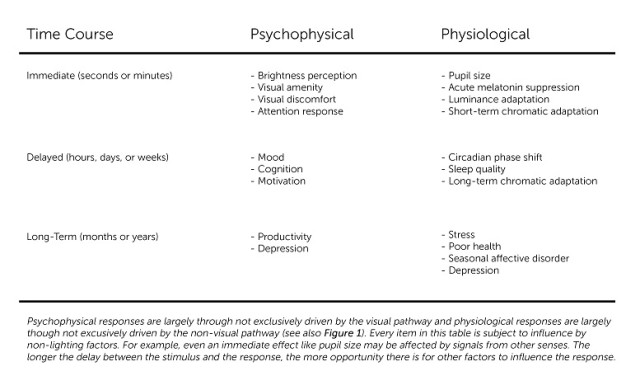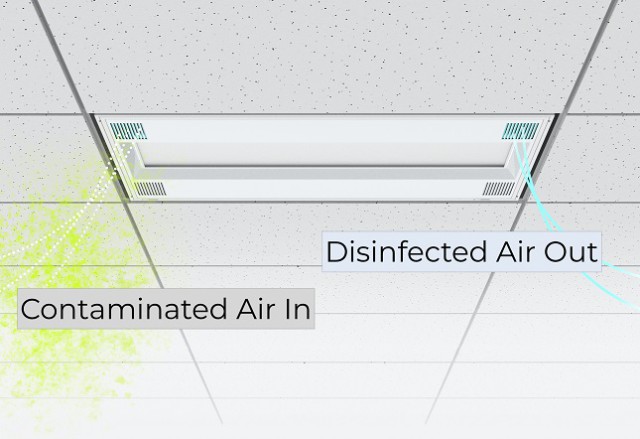Delivering Human-Centric Lighting to the Masses

Christopher Johnston, Director of Total Sustainability, Energy Focus, Inc. shares the impact lighting design has on health & wellbeing.
Human Centric Lighting (HCL) is an increasingly common topic for discussion among facility executives. HCL has already been employed in facilities to increase occupant wellness by maintaining their circadian rhythms and improve productivity by stimulating the natural cycle of melatonin and cortisol. While its adoption is currently limited to more upscale facilities, lighting control technology is rapidly advancing with cost of ownership declining and will likely be attainable for most facilities by 2023.
HCL encapsulates the lighting design tenets that aim to maximize the health and wellbeing of the building’s occupants. In practice this includes compliance with the guidelines for light level and quality, to avoid glare and flicker while maximizing colour rendition and often takes the design a step further by mimicking the natural day/night cycle to entrain the body’s circadian rhythm. Although no standard for circadian lighting is currently available through the American National Standards Institute (ANSI), International Electrotechnical Commission (IEC), or International Organization for Standardization (ISO), both Underwriters Laboratories (UL) and the International WELL Building Institute have published guidelines for day-active people.
Pain and headache reports
Considerations for healthy lighting should begin with the guidance that is easiest to implement, such as ensuring proper light levels and reducing the possibility of introducing lighting with non-visible flicker. Flicker is an often overlooked yet critical element to consider for any LED-based lighting design. High flicker rates, caused by the modulation of the AC power line, have been associated with headaches, eye strain and fatigue, and a study published in Current Pain and Headache Reports attributed visual triggers such as flicker to 38% of reported migraines. Advancements in electronic ballasts for fluorescent lamps drastically reduced the flicker that was associated with their magnetic ballast predecessors; however, many LED products inadvertently re-introduced these high flicker rates. A simple method for determining whether an LED lamp is designed to eliminate flicker is to look for UL-verified “Low Optical Flicker” LEDs, which are certified to produce less than 1% flicker.
Taking lighting systems to the next level of wellness means incorporating dimming and colour-tuning to allow occupants to finetune their localized lighting to meet their preferences and automated systems to entrain, or to get in sync with occupants’ circadian rhythms. According to Human-Centric Lighting: Foundational Considerations and a Five-Step Design Process, the non-visual benefits associated with a properly entrained circadian rhythm range from improvements in sleep quality to a healthier immune system. Numerous studies have demonstrated that these same benefits are amplified when HCL is employed in assisted living facilities and nursing homes. A study led by the Lighting Research Centre, titled Tailored lighting intervention improves measures of sleep, depression, and agitation in persons with Alzheimer’s disease and related dementia living in long-term care facilities, found that lighting designed to increase daytime circadian stimulation significantly improved night-time sleep efficiency, reduced nocturnal wandering, and alleviated evening agitation in patients with Alzheimer’s disease and related dementia.
Circadian lighting, a subset of HCL, capitalizes on light’s role in numerous biological cycles. As the primary “zeitgeber” or “time giver” for the circadian system (the body’s internal clock), light helps align one’s body to the 24-hour sleep-wake cycle. This is achieved by altering the brightness and colour temperature of indoor lighting throughout the day to mirror the rising and setting of the Sun. Brighter light and higher or cooler colour temperatures suppress melatonin, keeping us alert and productive, while dimmer light and lower or warmer colour temperatures have the opposite effect and help induce states of relaxation. The research article Circadian Rhythm Disruption and Mental Health explains how circadian rhythm entrainment or disruption is intricately linked to mood and associated psychiatric disorders. The researchers also found that individuals suffering from disrupted circadian rhythms are at a higher risk for cardiovascular disease, certain cancers, and diabetes.
Control system
Fortunately, the only technologies necessary to mimic natural light indoors are dimming and colour tuning LEDs paired with a control system that allows for manual finetuning or automated light adjustments. Colour-tuning options are currently most prevalent with wireless systems, which are more than capable of meeting circadian lighting requirements. However, wireless systems often introduce their own issues with security and programming/use complications, so many facilities look to wireline or powerline communication protocols. Until recently, low-voltage and phase-cut controls were the only options available. While low-voltage dimming systems are highly efficient they don’t offer colour-tuning capabilities, and facilities without existing low-voltage wiring will bear the additional cost of running new wires. Phase-cut controls can similarly incur additional expenses by introducing noise to the line.
Advancements in powerline control have enabled colour tuning and dimming via a simple retrofit of existing lighting systems, with no commissioning required. Instead of modulating the powerline, and introducing potential noise issues, the control switch briefly interrupts it. This interruption signals the associated lamps to, for example, change colour temperature or brightness without disrupting the light output. In this way, unlike more complex powerline communication systems, only lamps on the switched line receive signals, which automatically associates the lamps with the control. This is an important development for the lighting industry, since such a system can be installed by simply replacing the existing lights with LED lamps and a switch.

FM’s aware of challenges
Modular, lamp-based lighting systems, often based on tubular LEDs (TLEDs) in commercial applications, are gaining popularity. One reason is facility managers are realizing the challenges to maintain and update integrated fixtures, which require whole fixture replacements when the LEDs burn out or electrical components fail. This generates unnecessary material wastes before the end of the product’s lifecycle. Modular lighting systems enable simple retrofit through lamp replacements and are future proofed to allow for cost-effective replacement when the lamps either reach the end of their useful lifecycle or when technology advances to the point where an upgrade is desired.
As LEDs became commercially viable in the context of their much more versatile form factors during the first decade of the 21st century, fixture manufacturers began integrating them directly into their products. The additional space for hardware afforded by this integration enabled them to not only present additional design potential but also achieve a fully managed heat dissipation system and additional lighting controls, such as wireless dimming and colour-tuning. However, over the past few years, innovations in LED as well as communications, electronics and software technologies have enabled high-quality LED tubes and lamps to catch up with and match the capabilities of integrated fixtures while still retaining the ease and affordability of installation and maintenance, achieving a superior sustainability profile.
New directive
This is a critical turning point in the HCL space, since not only will more technologically advanced lighting improve human lives, but it will also reduce the environmental impact of the lighting. While this direction was initiated by manufacturers taking advantage of improvements of exponential technologies such as electronics and software, the new European Eco-design requirements are accelerating the trend. The directive, which will come into effect in the latter half of 2021, sets minimum mandatory requirements for energy efficiency, lamp lifetime, and requires that light sources can be easily replaced using commonly available tools. It’s also expected that the UK government will effectively mirror the regulation so that UK and EU regulations remain aligned.
Beyond the visible spectrum of light, certain wavelengths can bring about even more potent health and wellness benefits. Ultraviolet (UV) disinfection has been used in air treatment systems since the 1930s to destroy a wide array of indoor airborne pathogens. UV-C lights disinfect surfaces and air by emitting short wavelength light in the 200 to 280 nanometre (nm) range. According to the Centres for Disease Control (CDC), 265 nm is most effective at inactivating viruses due to its ability to render pathogens incapable of replicating by damaging the DNA and RNA strands. Due to the dangers posed by UV, self-contained UV-C disinfection units limit the harmful UV rays to airborne pathogens drawn through the device. Such in-room air disinfection units act as a continuous, vigorous safety measure that can be employed while occupants are in the space. The most advanced versions of these units combine colour-tuning and dimming systems with active air disinfection in the same lighting troffer, thus maximizing the human-centric benefits.
Advances in LED and UV-C technologies have enabled simple and affordable retrofits that improve occupant health and wellbeing. Modular HCL systems can be replaced at a lower cost and generate significantly less environmental waste, taking into account the future implications of lighting installed today while maximizing the non-energy benefits in the process. For the immediate future, lighting that provides circadian capabilities will afford significant human comfort, productivity and health benefits while UV related innovations will provide a safer environment that is crucial for bringing people together and back to work. There has never been a better time to direct your attention up, to your lighting, for triple bottom line benefits: health, environmental, and financial.







